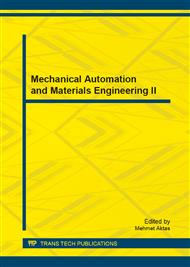p.383
p.387
p.391
p.395
p.400
p.405
p.410
p.415
p.420
Research on Aero-Engine Gas Path Detection System Based on Electrostatic Induction
Abstract:
A large number of charged particles exist in the aero-engine gas path, the electrostatic monitoring technology mainly monitors the electrostatic charge in the exhaust gas of aero-engine by arranging an electrostatic sensor, and predicts the performance and working state of gas path components by using signal process algorithms and intelligent decision model. Considering the characteristics of the aero-engine gas path and the requirements of the gas path parameter detection, an electrostatic induction-based electrostatic sensor is built to detect the anomalously charged particles in the gas path on line, providing an important basis for aero-engine Prognostics and Health Management (PHM). Simulation experiments are implemented to investigate the time response and frequency characteristic of the output signals of the sensor and analyze the influence factors.
Info:
Periodical:
Pages:
400-404
Citation:
Online since:
June 2014
Authors:
Price:
Сopyright:
© 2014 Trans Tech Publications Ltd. All Rights Reserved
Share:
Citation:


